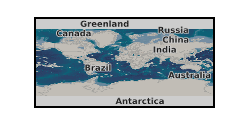Random Forest model output prediction raster for the occurrence of Fe-Mn in the World Oceans
The raster provide the output of a machine-learning random forest algorithm modelling the occurrence of ferromanganese (Fe-Mn) crust deposits in the world ocean. This raster constitutes a data-driven approach for mineral prospectivity mapping of Fe-Mn crusts that should be used in conjunction with other expert-driven prospectivity analysis to guide the assessment of Fe-Mn crust coverage in the world ocean and potential mineral exploration. The raster contains values between 0.07 and 0.92. Any values outside of that range (e.g., 0) are outside of the model prediction and should not be displayed. To reproduce data as displayed in the forthcoming associated publication, it is recommended to apply a 'Percent Clip' stretched 'Viridis' colour scheme.

non geographic dataset
:
http://data.bgs.ac.uk/id/dataHolding/13607985
English
Geoscientific information
GEMET - INSPIRE themes, version 1.0:
BGS Thesaurus of Geosciences:
Mineral exploration
Ferromanganese
Submarine mineral deposits
UK Location (INSPIRE)
Earth crust
Free:
Free:
NERC_DDC
creation: 2022-09-28
2020
-
2022
British Geological Survey
Enquiries
Environmental Science Centre, Nicker Hill, Keyworth,
NOTTINGHAM,
NG12 5GG,
United Kingdom
tel: 0115 936 3143
email:
enquiries@bgs.ac.uk
Role: distributor
British Geological Survey
Enquiries
Environmental Science Centre, Nicker Hill, Keyworth,
NOTTINGHAM,
NG12 5GG,
United Kingdom
tel: 0115 936 3143
email:
enquiries@bgs.ac.uk
Role: originator
British Geological Survey
Enquiries
email:
not available
Role: distributor
British Geological Survey
Enquiries
email:
not available
Role: originator
British Geological Survey
Enquiries
email:
not available
Role: point of contact
Data Quality
The raster dataset correspond to the output of a random-forest algorithm data classification. The model uses a set of known locations for deposit and non-deposit samples to fingerprint the geospatial signature of each class against a range of environmental and geological variables, also referred to as predictors. The multivariate geospatial signature of each pixel covered by all predictors is then used to predict the likelihood of occurrence of the target class. This prediction takes the form of a raster data set with value between 0 and 1 marking the confidence in the prediction of the target class.
INSPIRE Implementing rules laying down technical arrangements for the interoperability and harmonisation of Geology
Commission Regulation (EU) No 1089/2010 of 23 November 2010 implementing Directive 2007/2/EC of the European Parliament and of the Council as regards interoperability of spatial data sets and services
Constraints
The copyright of materials derived from the British Geological Survey's work is vested in the Natural Environment Research Council [NERC]. No part of this work may be reproduced or transmitted in any form or by any means, or stored in a retrieval system of any nature, without the prior permission of the copyright holder, via the BGS Intellectual Property Rights Manager. Use by customers of information provided by the BGS, is at the customer's own risk. In view of the disparate sources of information at BGS's disposal, including such material donated to BGS, that BGS accepts in good faith as being accurate, the Natural Environment Research Council (NERC) gives no warranty, expressed or implied, as to the quality or accuracy of the information supplied, or to the information's suitability for any use. NERC/BGS accepts no liability whatever in respect of loss, damage, injury or other occurence however caused.
Either: (i) the dataset is made freely available, e.g. via the Internet, for a restricted category of use (e.g. educational use only); or (ii) the dataset has not been formally approved by BGS for access and use by external clients under licence, but its use may be permitted under alternative formal arrangements; or (iii) the dataset contains 3rd party data or information obtained by BGS under terms and conditions that must be consulted in order to determine the permitted usage of the dataset. Refer to the BGS staff member responsible for the creation of the dataset if further advice is required. He / she should be familiar with the composition of the dataset, particularly with regard to 3rd party IPR contained in it, and any resultant use restrictions. This staff member should revert to the IPR Section (ipr@bgs.ac.uk) for advice, should the position not be clear.
Metadata about metadata
eaec2401-f090-18e7-e053-0937940aa3f2
British Geological Survey
Environmental Science Centre, Keyworth,
NOTTINGHAM,
NG12 5GG,
United Kingdom
tel: +44 115 936 3100
email:
enquiries@bgs.ac.uk
Role: point of contact
2024-04-24
